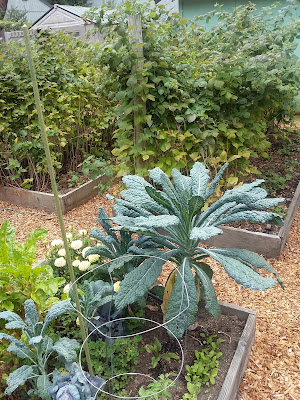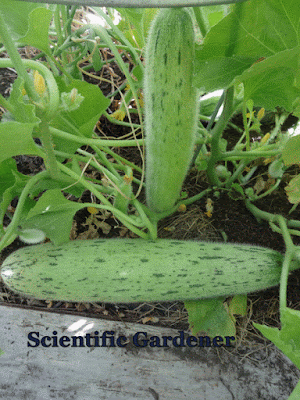For years I have been overly suspicious of the Brassica family. Growing up, I remember seeing cabbage butterflies annihilate cabbage plants and not caring much for the taste of coleslaw or sauerkraut. Later, the only thing I correlate cabbage with is boiled cabbage, which gives me indigestion. The few experiences I had with growing Brassicas included growing broccoli and Brussel Sprouts, which were a lot of hard work for a meager crop. Then a few years back I heard tales of a super-rich nutrient-packed vegetable called Kale. A good friend of ours even introduced us to Kale chips – an incredibly tasty and healthy snack whose flavor was reminiscent of a fine cheese. Recently, with moving to California and having easy access to cheap kale, I thought I would give it a try - and I started liking it.
While consuming kale in soups last winter, I read a book that mentioned perennial kale – and I was hooked. The idea of having a plant I did not have to re-plant year after year really appealed to me. You mean that I can access a healthy vegetable any time I want – with minimal effort? You bet!
Being the resourceful individual that I am, I presented my desire to identify a local source for some perennial kale to individuals at my local county garden extension class and happened to find that a master who possessed some tree collards that he was happy to share with me. It turns out that they are that tree kale and perennial collards are the same thing.
So far so good. I read that tree kale/perennial collards require a lot of calcium, so I made sure to add a lot of crushed egg shells in the hole where I deposited each plant. They have done incredibly well. The only other thing I would have done, if I had a chance, would be to stake them. That being said, the location that I planted them, they were able to lean up against the fence, then against the greenhouse.
I believe if I continue to plant them further down the fence line, like I plan to do next spring, I will need to stake them. Other than the plants getting a little too large mid-summer, they have been relatively simple and easy to care for. Also – I still don’t care much for the cabbage butterflies that the plants attract to the yard. In the spring, it took some concerted effort to fight against the caterpillars, but by the summer it paid off – when spiders, small wasps and other critters began helping me by preying on the caterpillars.
I take as many of the lower leaves as I want, whenever I want. We have enjoyed our collards a lot in both soups and stir-fries, though I have not tried making kale chips yet. As for their care, I occasionally add some additional egg shells and nitrogen or compost and watch them grow. I'm excited to see them change color this winter - as I have heard they turn a reddish-purple as the days get shorter. So far, I am an extremely proud owner of some Tree Kale… or Perennial Collards.
 |
| My Tree Chard/Perennial Kale - March 3rd |
While consuming kale in soups last winter, I read a book that mentioned perennial kale – and I was hooked. The idea of having a plant I did not have to re-plant year after year really appealed to me. You mean that I can access a healthy vegetable any time I want – with minimal effort? You bet!
 |
| March 25th after a light rain. |
 |
| Perennial Kale, April 25th |
Being the resourceful individual that I am, I presented my desire to identify a local source for some perennial kale to individuals at my local county garden extension class and happened to find that a master who possessed some tree collards that he was happy to share with me. It turns out that they are that tree kale and perennial collards are the same thing.
 |
| Tree Collards in May |
 |
| It looks like I got the greenhouse in May as well. |
So far so good. I read that tree kale/perennial collards require a lot of calcium, so I made sure to add a lot of crushed egg shells in the hole where I deposited each plant. They have done incredibly well. The only other thing I would have done, if I had a chance, would be to stake them. That being said, the location that I planted them, they were able to lean up against the fence, then against the greenhouse.
 |
| Perennial Kale in June - lower leaves do die out a bit as the plant matures. |
 |
| Fuzzy Cabbage Butterfly Caterpillar |
 |
| Some of the caterpillars were less fuzzy, with a white stripe. |
I believe if I continue to plant them further down the fence line, like I plan to do next spring, I will need to stake them. Other than the plants getting a little too large mid-summer, they have been relatively simple and easy to care for. Also – I still don’t care much for the cabbage butterflies that the plants attract to the yard. In the spring, it took some concerted effort to fight against the caterpillars, but by the summer it paid off – when spiders, small wasps and other critters began helping me by preying on the caterpillars.
 |
| Tree Chard, August - at just above 5' tall. |
I take as many of the lower leaves as I want, whenever I want. We have enjoyed our collards a lot in both soups and stir-fries, though I have not tried making kale chips yet. As for their care, I occasionally add some additional egg shells and nitrogen or compost and watch them grow. I'm excited to see them change color this winter - as I have heard they turn a reddish-purple as the days get shorter. So far, I am an extremely proud owner of some Tree Kale… or Perennial Collards.
 |
| Middle Perennial Kale is just reaching 6' by September |














































